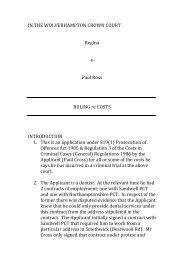You also want an ePaper? Increase the reach of your titles
YUMPU automatically turns print PDFs into web optimized ePapers that Google loves.
Let us measure then the judgment in Jogee against the two criticisms of the
previous law identified by the Supreme Court above, that is, the anomaly of
different mental thresholds for guilt and the lack of clarity, to see the extent to
which those matters have been corrected.
In other words, is there now parity of intention between principal and accessory
and clarity of the law. Hence the title of this presentation.
Principles ‘Re-Stated’
Turning away from the doctrine of parasitic accessory liability, the Court instead
‘restated’ the following principles (as far as tghey can be readily identified):
• Accessory liability requires proof of a conduct element accompanied by
the necessary mental element (paragraph 7).
• The requisite conduct element is that D2 has encouraged or assisted in
the commission of the offence by D1 (paragraph 8).
• Secondary liability does not require the existence of an agreement
between D1 and D2. Where, however, it exists, such agreement is by its
nature a form of encouragement and in most cases will also involve acts
of assistance (paragraph 78).
• Once encouragement or assistance is proved to have been given, the
prosecution does not have to go so far as to prove that it had a positive
effect on D1’s conduct or on the outcome (paragraph 12), unless anything
said or done by D2 has faded to the point of mere background such that it
can be regarded as spent or has become spent by some overwhelming
intervening occurrence (paragraphs 13 97). In that case, the defendant
will bear no criminal responsibility for the principal’s actions (paragraph
97).
4










